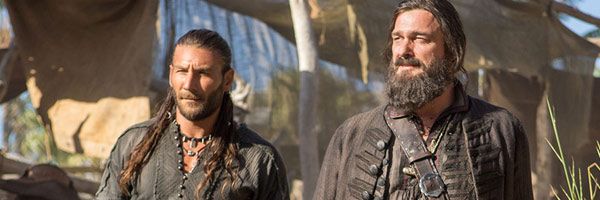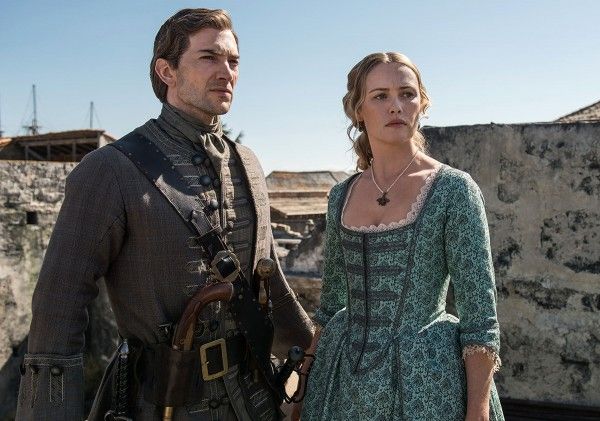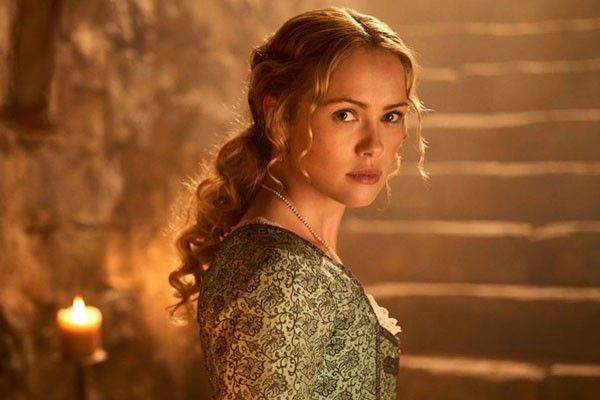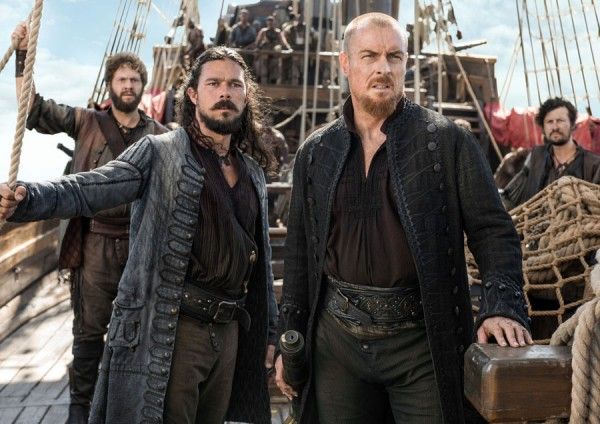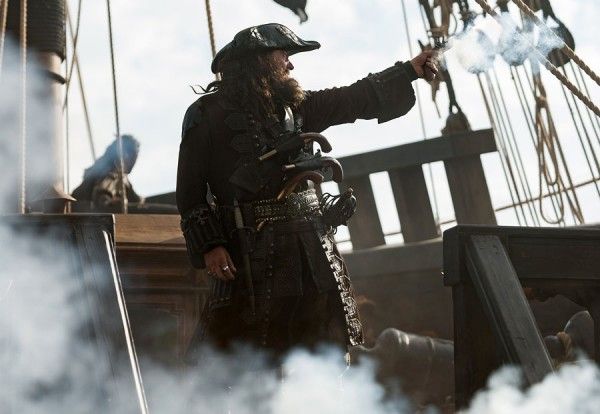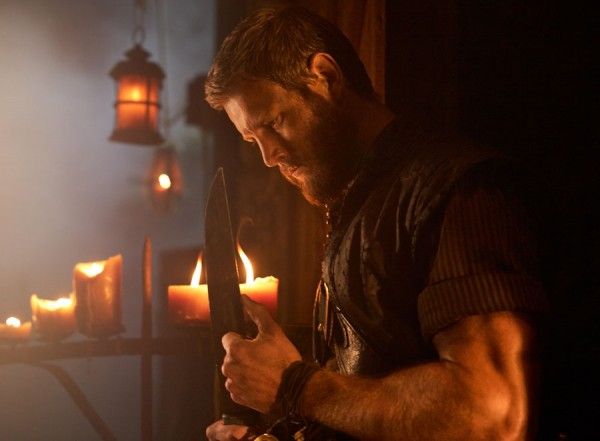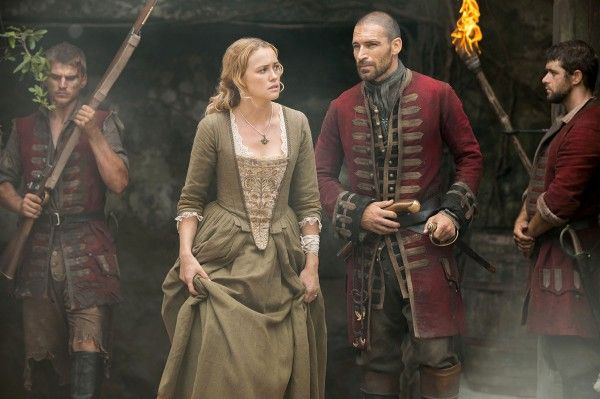For four seasons, the Starz drama series Black Sails has been one of the biggest, most epic, most impressive productions on television. Its excellent storytelling, expert production design and terrifically talented cast of actors gave us heroes to root for and love, and terrifying villains that we could hope those heroes ultimately escaped. It’s sad to say goodbye to a series that has exemplified such excellence throughout its run, but we can still imagine where those who survived sailed off to next and mourn those that we lost.
To reflect on the four-season run that they can be undeniably proud of, showrunners Jon Steinberg and Robert Levine got on the phone with Collider to talk about the responsibility of making a show they’d love to watch, what they’ll take from the experience of making Black Sails, figuring out the fates of the characters, the final moments between Captain Flint (Toby Stephens) and John Silver (Luke Arnold), whether they ever thought about exploring Treasure Island, what’s next for Jack Rackham (Toby Schmitz) and Anne Bonny (Clara Paget), and what they took from the set.
Be aware that there are MAJOR spoilers discussed from throughout the series.
Collider: Do you feel that Black Sails has been truly appreciated for just how good it is and the quality of excellence that it displays, or do you think it’s one of those shows that’s been sadly underappreciated and it will be discovered by more people when they watch it, after it’s all over?
JON STEINBERG: I don’t know. I’m not sure I’m allowed to answer that question because we’re in it too deep. I will say this, for both of us, as an understanding of what our jobs are and aren’t, I feel like we approach this where our responsibility is to make something we’d love to watch, and try to do it in a way where it will hold to as much investment or scrutiny as you feel it deserves. I think we did that, and I think we’re pretty proud of where it landed. Whatever it turns into when you put it into the world is in the hands of the gods. All you can do is keep doing the work. It would definitely be nice, if it was a thing that continues to live and that people continue to find. Hopefully, it will age well.
After four seasons and getting to wrap up this show the way that you wanted, what will you take with you from the experience of making Black Sails? Are there things that you learned from making this show that will make the next show easier, or is that even possible to do?
STEINBERG: Well, it can’t be any harder! I think that’s a safe bet.
ROBERT LEVINE: Never get on the boat!
STEINBERG: No kids, no animals and no ships. That’s the new rule for us. We are both different writers and different producers, after six years of making this show, and having been given the freedom to do things that a lot of people have very long, successful careers and don’t have the opportunity to try. We’re really appreciative of having been given that. I think the next show will be easier, for a number of reasons, both because of this experience and because we were determined to make this as difficult as possible. But, I think these things are always difficult. If it’s not difficult, than you’re not doing the job.
Especially with this last season, when did you what the end point would be for each of these characters? Did you know how all of them would fare by the finale, when you started the season, or did you find some of their paths, along the way?
LEVINE: It’s always a little bit of both. You’re always trying to forge ahead and fumble around in the dark. You know where you’re going and aim in that direction, but you have to be ready for the story to speak to you and surprise you and suggest something different. The Flint and Silver ending, in its outlines, has always been there. We always knew that that was the climax of the story throughout, for both of them. It’s the most important relationship, for both of them. When it finally reached this moment of going from two people who seem to have nothing in common to being wary of each other to being opportunistic allies and then friends to two people who know each other better than anyone else in the world, and then finally reaching that point of not being able to go forward, was going to shape the end of their story. The specifics of when and how gradually became more clear, but we knew that that’s where the show and the season were specifically headed.
Do you think that Silver would have eventually come to the same conclusion about what he was going to do with Flint, or was his decision influenced by constantly having people in his ear about it?
STEINBERG: I don’t think it’s a choice he would have made, 10 episodes ago. It feels like it’s a choice that was made only because of the two massively formative relationships that have developed and become that way, in Season 4. A lot of the people who were in his ear were largely manifestations of the voices that he was already hearing in his own head, giving him that internal conflict, whether it’s Billy or Hands or Madi, or whomever. It just felt right, as a way to finish telling his story, that his story ends with him conceiving of this act of mercy. It felt like a way to spin the way you find these characters in Treasure Island, in a way that felt interesting and a little unexpected.
How did you come to decide that this is what Flint’s fate would be, and that we would be left questioning whether or not that’s really the truth?
STEINBERG: When you read the book, you’re told that Flint died in a very specific way, and it’s a way that doesn’t immediately suggest story. He died alone, some indeterminate period of time after the exciting stuff happened, and he died in a very lonely, sad place. When we talked about planting flags in the ground of things that we considered to be canon, and you have to account for them, that was one of them. It felt like it was important, and it felt like a challenge to figure out how we could acknowledge that and also make it work for us, and recontextualize it and make it a bit of a mystery. There’s a lot of people telling a lot of stories in Treasure Island, and a lot of people telling stories in this show. If this show is about anything, it’s about the fact that narrative can be a very powerful thing, when used properly. So, it felt right that the ending was steeped in that idea.
It definitely felt like these characters were presented with the choice of either creating their own narrative or living up to the narrative that people have created for them.
STEINBERG: Exactly!
LEVINE: Yeah.
It seems as though Flint’s love for Silver was stronger than his good sense towards him. He seems to have known, deep down, that Silver was going to betray him, and yet he stood by his side anyway. Did Flint ultimately care more about Silver and their partnership than Silver cared about him?
LEVINE: Wow, that’s tough. It’s hard to say.
STEINBERG: I think that relationship is meaningful to both of them. It is singular, for both of them. We’ve never seen Silver invest in someone, in this way. So for him, it’s very new. It’s the first one of these relationships that we are aware of. We’ve seen Flint invest in people before, but not in this way, where he has allowed himself to be both Flint and McGraw, openly, and found some measure of comfort in that state. So for him, it’s new, also. I would argue that it’s not a contest, as to which of them felt it more deeply, but I think it was definitely meaningful. Personally, there wasn’t ulterior motives in their affinity for each other. It is genuine and it is complicated, in the way that it’s always complicated when you love someone. You don’t always make the best decisions when that thing is threatened. It’s very hard to conduct a post-mortem when relationships like that are involved, in terms of figuring out what promoted you to do what. That felt true and right, and I think we resisted the urge to simplify it, when given opportunities to, because it felt like it suddenly became less interesting.
In that final moment that Silver and Flint have on screen together, how close is John Silver to the Long John Silver of Treasure Island? Are they now one in the same, by that point, or does he still have a ways to go?
STEINBERG: To me, what is interesting is that, in that moment, he is completely determined to never be that guy. He is determined not to be a character in a story that someone else is telling. He is determined not to be the villain that he has felt like, for this whole season. And in that moment, Flint tells him, “You will be, one day. This life you have chosen for yourself won’t be enough, and you’ll have to come back to this character to find meaning in it.” And he’s right. Now Treasure Island, just in its existence, is the fulfillment of Flint’s curse. At some point, John Silver is going to not be satisfied in being John Silver anymore, whether that’s five years later or 15 years later, or who knows how long, and he’s going to feel the need to be Long John Silver again. That money in the ground is just a totem for it, but ultimately, the curse is more about that than it is about ghost stories, or anything else.
When you spend so much time with these characters, I would imagine that you love them as much as the audience does. Had you thought about the possibility of exploring Treasure Island, as a story, or do you want to close the book on pirates?
LEVINE: Being somewhat candid, we did think about it. Whether it was in wondering if this was where the show wanted to end or if there was more story, it did come up. But, I think we’re happy with this ending. It’s close to the story that we set out to tell, and it gets you close enough to Treasure Island where the book can be meaningful as an addendum, if you were to read it again. Now you could read it as the fulfillment of a prophecy on Flint’s part, for Silver, and not just an adventure story about a young Jim Hawkins. There’s another interpretation where this is Silver trying to maintain the narrative that he’s built, at the end of our show, of Flint’s ending and where the treasure belongs. The fact that Billy is disturbing it again is messing with that narrative, and that needs to be answered. It has all kinds of interesting interpretations and, in some ways, it’s fun to let the book do that, as opposed to us needing to adapt it and give you a specific version of it.
Why did you decide to essentially end things with Jack Rackham and Anne Bonny sailing off together? Was it to leave people with some sense of hope, where the pirates are concerned?
STEINBERG: It was a number of things. In the broadest sense, it felt right that this show was always about contextualizing these people. Pirates didn’t live in Neverland. They existed in a world that lived before them and that would exist after them, and that they were connected to. It felt right that, at the end of this story, there is the suggestion that it isn’t over. These things don’t just end that cleanly. There’s always been some desire, at the end of this show, to make some comment about what piracy was and what we understood it to be, before you started watching the show or putting a lot of thought into it. We liked this idea that, in that final moment of the show, that has been, from the beginning, about upsetting your expectations about what pirates are, it is the first time that you’re shown a symbol that you would have understood, at the beginning, as being what pirates are about. In some respect, that is the sense of their immortality. This symbol, for whatever it means in the eye of the beholder, is a thing that survived them all by centuries, literally. Jack felt like the right person to be allowed to see that, and it also felt right that, in that moment of seeing it, it wouldn’t be good enough for him. And on some level, we just loved them. You try to be true to the characters and to the story, and to be unflinching, in terms of what it wants and what it implicates, but we need to have fun, too. So, there’s a touch of that, as well.
What made you decide to introduce Mark, or Mary, Read at the very end? She’s one of the most famous female pirates, along with Anne Bonny, but we only get to meet her at the end of the series. How did that come about?
STEINBERG: That’s part of the idea that the show is ending, but they’re not. For some of them, the most interesting things that have ever happened to them have happened already, but for some of them, there is the sense that life goes on. They are the ones that are left to be witnesses to the things we saw. If Mary Read isn’t at the end, you don’t get that feeling or that sense of, “Oh, there’s more. I know there’s more because I know the three of them are relevant to each other and have a whole story amongst them.” I think that feeling of there being all of this weight ahead of you, after the ending, gives you the feeling that it’s not entirely over.
What was the biggest challenge of Season 4, and what do you feel was its biggest accomplishment?
LEVINE: We’re gluttons for punishment and we always love a challenge, going into a season. We didn’t want to repeat stuff we’d done before. We wanted to figure out ways to go even bigger and expand the world, and do set pieces that were far and beyond what we’d done before. We really pushed the production, the scale and the scope of things. In this case, that was almost from minute one. There was this idea of taking Flint from a position of having one improbable victory and having England on the run, knowing that the story can’t just start with him sitting pretty, so we had to pick up with him, with the wind in his sails, and then have it, just as quickly, taken from him. And then, we went underwater. Crafting the sequences of the Spanish finally delivering on that promise, and then even in the finale with the need to resolve all of those conflicts in a way that was really exciting and also felt like something we hadn’t done before, was all very challenging and required not just ideas from the writers, but directors that were capable and actors who were pushed to the very brink of exhaustion. We were always testing what we’d done before.
In four seasons, what did you enjoy most about working with this cast and watching them bring these characters to life?
STEINBERG: They’re pretty great. When you’re casting a series, there is a bit of box of chocolates to it. You do the best you can to find people that can do the work, that are interesting, and that you want to spend years of your life with, but it’s far from a slam dunk that you’ll bat a thousand, when you start doing that. But, we did and it was luck. I don’t think there was any way we could have known we were putting this group together. The thing for me that I feel least entitled to and most appreciative of, besides the fact that they’re all immensely talented, is how much they love the show, as measured by how excited they were about other people’s stories and scenes, and how selfless they were about subordinating their inconveniences, which were significant. They were living very far away from home, for a long time. There were moments when I think all of them looked at something and wondered what the hell we were thinking, but trusted us that it was part of something they would ultimately feel proud of and excited by. After that happens once or twice, either people tune out because they’re tired of being put through that roller coaster, or they just buy in and want to be a part of something like this. And without exclusions, this cast did that, from day one. That makes you thankful and it makes you feel sad ‘cause you’ll probably never get that again.
People always talk to the actors about what they wanted to bring home from the set, once a show is done, but was there anything that you wanted to keep and take home from the set, to commemorate the blood, sweat and tears that you put into this show?
STEINBERG: Yeah. I know that Toby said, “I just want to leave it behind and have the memories,” but I’m way too swag oriented, so I took Eleanor’s chair. That felt right. We had a bunch of stuff that got shipped back. One of the treasure chests might be in my garage.
LEVINE: I go even deeper into the arcane. Our production designer does these amazing graphical, hand-drawn, length of a room drawings of these sets before he builds them, so I have his drawing of Philadelphia framed and in front of my desk. That feels very authoritative and beautiful. And then, Toby Schmitz would draw these New Yorker-style editorial cartoons, featuring characters from the show. I have at least two of those somewhere, and I think Jon does, too. It was such a brilliant experience. Like Jon said, it’s hard to imagine it being replicated with that much enthusiasm, throughout the cast and the production, from Starz to Platinum Dunes to everyone. We all just wanted to make a great show, and we believed in it.

